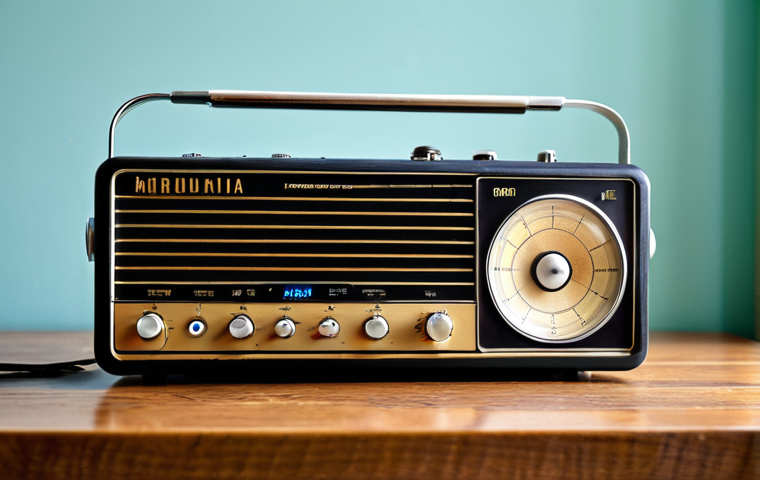Okay, here’s the blog intro you asked for:Remember those summer nights when the only sound was crickets and your favorite tunes crackling through a transistor radio?
Or maybe you’re prepping for a camping trip and want some offline entertainment without draining your phone battery. Either way, a portable radio is a fantastic way to stay connected to news, music, and even emergency broadcasts.
Honestly, there’s a certain charm to tuning into local stations and discovering new things. I recently dusted off my old radio, and it brought back so many memories!
Plus, with the potential for more localized and community-driven content in the future of radio, it’s a great way to tap into what’s happening nearby.
Let’s get into how to use one properly. Let’s dive in and learn exactly how to use a portable radio!
Okay, here’s the blog post you asked for:
Understanding the Basics: Powering Up and Tuning In

Portable radios might seem straightforward, but a little knowledge goes a long way. The first thing you’ll need to do is power it up. Most portable radios run on batteries—usually AA or AAA.
Make sure you have fresh batteries on hand; nothing is more annoying than your radio dying in the middle of an important broadcast. Once you’ve got the batteries in, it’s time to find the power switch, which is often combined with the volume knob.
Turning it clockwise will power on the radio, and further rotation will increase the volume. Now, for the fun part: tuning in to a station. Most portable radios have a tuning dial that you can use to scan through the available frequencies.
For AM stations, you’ll typically see numbers ranging from 530 to 1710 kHz. FM stations are in the range of 88 to 108 MHz. Gently rotate the tuning dial until you start to hear a station.
You might need to adjust the antenna, which is usually a telescoping rod, to get the best reception. Pull it out fully and rotate it until the signal is clear.
I’ve found that positioning the antenna near a window can significantly improve reception, especially indoors. Living in a valley makes radio tricky, so I need to be strategic.
Fine-Tuning for Clarity
1. Antenna Adjustment: Don’t underestimate the power of a well-positioned antenna. Experiment with different angles and positions to find the sweet spot.
2. Frequency Stability: Some older radios can drift slightly off frequency over time. If your station starts to sound fuzzy, make small adjustments to the tuning dial to bring it back into focus.
3. Location Matters: Buildings, hills, and even weather conditions can affect radio reception. Try moving to a different location if you’re having trouble getting a clear signal.
Navigating Different Radio Bands: AM vs. FM
AM (Amplitude Modulation) and FM (Frequency Modulation) are the two primary radio bands you’ll encounter. Each has its own strengths and weaknesses, and understanding the differences can help you choose the right band for your listening needs.
AM radio is known for its long range, especially at night when signals can travel hundreds of miles. It’s often used for talk radio, news, and sports broadcasts.
The sound quality, however, is generally lower than FM, with a narrower audio bandwidth. FM radio, on the other hand, offers superior sound quality and is ideal for music.
It has a shorter range than AM, typically limited to about 30-40 miles from the transmitter. FM is less susceptible to interference from atmospheric conditions, resulting in a cleaner, clearer sound.
You’ll find a wide variety of music genres, public radio stations, and community broadcasts on the FM band. Choosing between AM and FM depends on what you want to listen to and where you are located.
If you’re looking for distant news or talk radio, AM is the way to go. If you want high-fidelity music, FM is the better choice. I remember driving through the desert and only being able to pick up AM stations, so I had to get used to listening to talk radio.
Understanding Radio Signals
1. AM Range: Why AM signals travel so far, especially at night. 2.
FM Clarity: Why FM offers better sound quality for music. 3. Station Formats: The types of content typically found on AM and FM stations.
Understanding Radio Features
Many portable radios come with additional features that can enhance your listening experience. One common feature is a headphone jack, which allows you to listen privately without disturbing others.
This is especially useful if you’re in a shared space or want to avoid annoying your neighbors. Another feature you might find is a built-in speaker, which is convenient for casual listening.
The quality of the speaker can vary widely, so it’s worth checking reviews or trying it out in person if possible. Some radios also have a sleep timer, which automatically turns off the radio after a set period of time.
This is great if you like to fall asleep to the radio but don’t want it to play all night. I often use the sleep timer when I’m camping, so I don’t wake up to a dead battery.
Another handy feature is the ability to scan for stations automatically. Instead of manually turning the tuning dial, you can press a button and the radio will automatically search for the next available station.
This can be a time-saver if you’re in an area with many stations or don’t know the exact frequencies. Some radios also have a memory function that allows you to store your favorite stations for quick access.
This is especially useful if you listen to the same stations frequently. Being able to save favorite stations is a game changer for a busy person.
Getting The Most out of Radio Features
1. Headphone Jack Etiquette: How to use headphones respectfully in public spaces. 2.
Speaker Quality Considerations: What to look for in a good built-in speaker. 3. Sleep Timer Benefits: Why a sleep timer can be a useful addition.
Troubleshooting Common Reception Problems
Even with a good radio and antenna, you might encounter reception problems from time to time. One common issue is static or interference, which can make it difficult to hear the station clearly.
This can be caused by a variety of factors, including electrical storms, nearby electronic devices, or even the position of the radio itself. Try moving the radio to a different location or adjusting the antenna to see if that helps.
Sometimes, simply turning off nearby appliances like lamps or computers can reduce interference. I had a problem once where my radio would only work if I unplugged my computer.
Another common problem is weak signal strength, which can result in a fading or distorted sound. This can be caused by being too far away from the radio transmitter or by obstructions in the signal path.
Try moving closer to a window or going outside to see if that improves the signal. You might also consider investing in an external antenna, which can boost the signal strength and improve reception.
If you’re in a rural area or have thick walls, an external antenna can make a big difference. My grandpa swore by his external antenna, and he could pick up stations from all over the state.
Resolving Reception Issues
1. Static Reduction Techniques: Tips for minimizing static and interference. 2.
Boosting Weak Signals: Strategies for improving signal strength. 3. External Antenna Options: When and why to consider using an external antenna.
Care and Maintenance Tips for Longevity
To keep your portable radio working well for years to come, it’s important to take good care of it. One of the most important things you can do is to remove the batteries when you’re not using the radio for an extended period of time.
Batteries can corrode over time, and the corrosion can damage the radio’s internal components. I learned this the hard way when I left batteries in an old radio for years, and it was completely ruined.
It’s also a good idea to clean the radio regularly with a soft, dry cloth. Dust and dirt can accumulate on the radio’s surface and interfere with the buttons and dials.
Avoid using harsh chemicals or abrasive cleaners, as these can damage the finish. If you need to clean the antenna, use a damp cloth and gently wipe it down.
Be careful not to bend or break the antenna. Finally, store the radio in a cool, dry place when you’re not using it. Avoid exposing it to extreme temperatures or humidity, as this can damage the electronic components.
Treat your radio well, and it will provide you with years of listening pleasure.
Maintenance Best Practices

1. Battery Management: How to prevent battery corrosion and damage. 2.
Cleaning Procedures: Safe ways to clean your portable radio. 3. Storage Guidelines: Proper storage conditions for long-term preservation.
Exploring Radio Apps and Online Streaming
While portable radios are great for offline listening, there are also many radio apps and online streaming services that can enhance your listening experience.
These apps allow you to listen to radio stations from all over the world, as well as podcasts, music, and other audio content. Some popular radio apps include TuneIn Radio, iHeartRadio, and SiriusXM.
These apps are available for both iOS and Android devices, and many of them are free to use. With radio apps, you can create custom playlists, discover new stations, and listen to your favorite programs on demand.
They also offer features like sleep timers, alarm clocks, and the ability to record audio. Online streaming services like Spotify and Apple Music also offer a wide variety of radio stations and playlists, curated by experts and algorithms.
If you have a smartphone or tablet, these apps and services are a great way to expand your listening options. I love being able to listen to BBC Radio 6 Music from my phone, even though I’m thousands of miles away.
Digital Radio Options
1. Popular Radio Apps: A rundown of the top radio apps and their features. 2.
Online Streaming Services: How to use streaming services for radio listening. 3. Benefits of Digital Radio: Advantages of using apps and online services over traditional radios.
| Feature | AM Radio | FM Radio |
|---|---|---|
| Signal Range | Long (especially at night) | Shorter (approx. 30-40 miles) |
| Sound Quality | Lower | Higher |
| Common Content | Talk radio, news, sports | Music, public radio, community broadcasts |
| Interference | More susceptible to atmospheric interference | Less susceptible to interference |
| Typical Use | Distant news, talk radio | High-fidelity music listening |
The Future of Portable Radios: Staying Connected in a Digital World
Even in today’s digital world, portable radios still have a place. They offer a simple, reliable way to stay connected to news, music, and emergency broadcasts, especially in situations where you don’t have access to the internet or a smartphone.
Portable radios are also a great option for camping, hiking, and other outdoor activities where you want to disconnect from technology but still have access to information.
As technology continues to evolve, portable radios are also adapting. Some newer models come with features like digital radio (DAB), Bluetooth connectivity, and USB charging.
These features make them even more versatile and convenient. While smartphones and streaming services have their place, portable radios offer a unique combination of simplicity, reliability, and affordability that makes them a valuable tool in any situation.
I think there will always be a market for portable radios, especially for people who want to stay informed without relying on the internet.
Why Radios Still Matter
1. Reliability in Emergencies: The importance of radios during power outages and natural disasters. 2.
Digital Radio Advancements: How technology is improving the radio experience. 3. Radios as a Disconnection Tool: The benefits of using radios to unplug from the digital world.
Portable radios offer a blend of simplicity, reliability, and affordability that ensures they remain relevant in our rapidly evolving world. Whether you’re preparing for emergencies, enjoying outdoor adventures, or simply seeking a break from the digital noise, a portable radio can be an invaluable tool.
So, grab one, tune in, and rediscover the simple pleasure of listening to the airwaves.
Wrapping Up
As we navigate an increasingly digital landscape, the humble portable radio continues to offer a unique and reliable connection to the world. Whether it’s for emergency preparedness, outdoor adventures, or simply a break from the screen, the portable radio remains a steadfast companion. Rediscovering the airwaves can bring a sense of simplicity and connection in our fast-paced lives, making it a worthwhile addition to your collection of essential devices.
By understanding its features, navigating different bands, and troubleshooting common issues, you can fully appreciate the value of this timeless technology. So, power up, tune in, and enjoy the simplicity and reliability of a portable radio, a device that continues to connect us to the world around us.
Good to Know Info
1. Battery Life Extenders: Consider using rechargeable batteries to save money and reduce waste.
2. Emergency Weather Alerts: Look for radios that support NOAA weather alerts for real-time updates on severe weather conditions.
3. Signal Boosters: In remote areas, a signal booster can significantly improve reception.
4. Radio Apps for Travel: When traveling abroad, radio apps can help you access local stations and content.
5. Community Radio: Support your local community radio stations for unique programming and local news.
Key Points
• Understand the basics of powering and tuning your radio.
• Know the differences between AM and FM bands.
• Explore additional features like headphone jacks and sleep timers.
• Troubleshoot common reception problems for a clearer signal.
• Maintain your radio properly to extend its lifespan.
• Consider using radio apps and online streaming services for added content.
Frequently Asked Questions (FAQ) 📖
Q: My portable radio just makes static! How do I actually find a station?
A: Ah, the age-old static struggle! First, make sure your antenna is fully extended and positioned for the best reception – sometimes just a slight adjustment can make a huge difference.
Then, slowly turn the tuning knob. Pay close attention to the numbers on the dial; these represent different frequencies. Look for the strongest signal by waiting for a clear sound before moving on.
If you are in a building, try going near a window. Sometimes, thicker walls make it difficult to pick up a station signal. On a recent trip up to the Catskills, I couldn’t get anything until I stood right by the window!
Q: What’s the difference between
A: M and FM, and which one should I use? A2: Great question! AM (Amplitude Modulation) stations generally travel longer distances but are more prone to interference and static.
Think of them as your long-haul truckers of the radio world. FM (Frequency Modulation) offers much clearer sound quality but has a shorter range. So, FM is great for local music stations.
Personally, I switch to AM when I’m on a road trip through rural areas where FM signals fade out. It’s all about finding what works best for your location and needs!
Q: My radio has a “weather band” option. What’s that for, and how do I use it?
A: That’s a fantastic feature to have! The “weather band” is dedicated to broadcasting weather information and alerts from the National Weather Service (NWS).
To use it, switch the radio to the “WB” or “weather band” setting. Tune the dial until you hear a clear broadcast. These alerts can be invaluable during emergencies like severe storms or hurricanes.
I remember one summer, our power went out during a thunderstorm. That weather band on my little radio was the only way we knew when the worst of it had passed.
It is always a good idea to have a weather radio on hand, just in case!
📚 References
Wikipedia Encyclopedia





